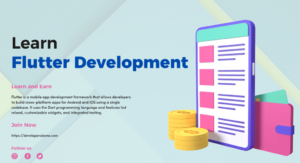Flutter development: Flutter is a tool that developers can use to build mobile apps for Android and iOS. It was created by Google and is open-source, which means that anyone can use it for free. One of the main benefits of Flutter is that it allows developers to make changes to their code and see the results right away, which helps them build apps more efficiently.
Flutter also has a large selection of pre-made widgets, which are like building blocks that developers can use to create the user interface (UI) of their app. These widgets help developers make their app look good and work well. In addition to building mobile apps, Flutter can also be used to build apps for the web and desktop computers. Overall, Flutter is a helpful tool for developers who want to create high-quality apps quickly and easily.
Contents
What is Dart?
Dart is the programming language that Flutter is built on. It is a modern, object-oriented language that is easy to learn and read.
Dart has a number of features that make it a good choice for mobile app development, including:
- Strong typing: Dart is a statically typed language, which means that variables have a fixed type and the type of a value is checked at compile-time. This can help catch errors early in the development process and make your code more reliable.
- Asynchronous programming: Dart has built-in support for asynchronous programming, which is important for mobile app development where you often need to wait for network requests or other long-running tasks to complete.
- Garbage collection: Dart uses a garbage collector to automatically manage the memory used by your app. This can help prevent common memory-related issues and make your code easier to write and maintain.
Why use Flutter?
There are several reasons why developers might choose to use Flutter:
- Fast development cycle: Flutter has a fast development cycle thanks to features like hot reload, which allows developers to quickly and easily test and iterate on their code.
- Native performance: Flutter apps are compiled to native code, so they run smoothly and efficiently on both iOS and Android devices.
- Rich set of built-in widgets: Flutter comes with a wide range of pre-designed widgets for building beautiful and responsive user interfaces.
- Strong support for integration with other platforms and services: Flutter has strong support for integration with other platforms and services, making it easy to build apps that work seamlessly with other tools and services.
What is the usage of Flutter?
A: Flutter can be used for a wide variety of mobile app development projects, including:
- E-commerce apps
- Social media apps
- News and media apps
- Business and productivity apps
- Education apps
- Gaming apps
How does Flutter compare to other mobile app development frameworks, like React Native?
Flutter and React Native are both popular mobile app development frameworks, but they have different strengths and weaknesses. Flutter’s main advantages include its fast development speed, its ability to build beautiful, native-looking apps, and its high-performance architecture. React Native, on the other hand, has a larger community and a wider range of third-party libraries and tools.
How to get started with Flutter
To get started with Flutter, you’ll need to do the following:
- Install the Flutter SDK and set up a development environment on your computer. This can be done using an IDE such as Android Studio or Visual Studio Code.
- Create a new Flutter project. This can be done using the Flutter command-line tools or through an IDE.
- Start building your app! Flutter offers a rich set of tools and widgets for building beautiful and responsive user interfaces, as well as strong support for integration with other platforms and services.
There are many resources available online to help you learn Flutter, including the Flutter documentation, tutorials, and examples. With a little bit of time and practice, you’ll be well on your way to building your own Flutter apps.
Conclusion
We’ve just scratched the surface of what Flutter and Dart have to offer, but we hope this introduction has given you a sense of what these technologies can do and how they work. If you’re interested in learning more, be sure to check out the Flutter documentation and the Dart language documentation for more information and resources. With a little practice and determination, you’ll be building beautiful, natively compiled apps in no time!
You may like:
Introduction to Android | Android development

Pingback: Flutter framework and its architecture Overview - Developers Dome